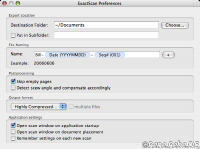Hi-MD && SonicStage? No, thanks Sony!
Saturday, August 26th, 2006I have the Sony MZ-RH 1 for some weeks now (see the blog entry about it) and the Sony Windows software named SonicStage gets on my nerves so badly it is worth another blog entry.
The Hi-MD and especially the MZ-RH 1 are really fantastic devices but the usability of the Windows music (mis-)management software Sonic Stage just sucks. Sorry Sony but that’s how it is and you can easily find out googling for it …
The Pro/Contra list boils down to this Cons:
- Windows only (showstopper alone)
- slow
- looks ugly (heavily overthemed)
- does not read all CD (e.g. some with copy protection that otherwise read out fine with other software and sometimes even not ordinary ones without any copy protection at all)
- mutable locks all over the place, e.g. no name or meta info editing while importing a CD and the like
- crashes more often than not
- once corrupted the MiniDisc’s data integrity and as a result crashed even more often and forced me to reformat the disc loosing all my music on it!
You miss the Pros? Sorry that’s right - there are no Pros (despite if you like to count “after a lot of caffeine it sometimes transfers music files to the player - that is if it was able to read the CD and did not crash on the way).
Now not only does Sony force us to use Windows software where many people these days happily have no Windows anymore at all - this software is as annoying as I seldom have seen any other software in this millenium. Especially not in the content providing industry. Look at Apple’s iTunes or other HD Player that allow you to just drag’n drop your files on the USB storage device.
A pity this Software really prevents the Hi-MD from becoming a success, especially as Sony allows to drag’n drop mp3 onto and out of other models including cell phones (such as the k750i and m600i). On those cells you even can push the files too all the other people in school, a party or all the stranger in the subway just fine!
For the brave hearted I decided to publish my first bits to read the TOC and print the offset positions of the on-disc data structures rather now than later. Maybe someone else will take a look and help out decoding more of the disc’s meta data and the like. Much luck!

